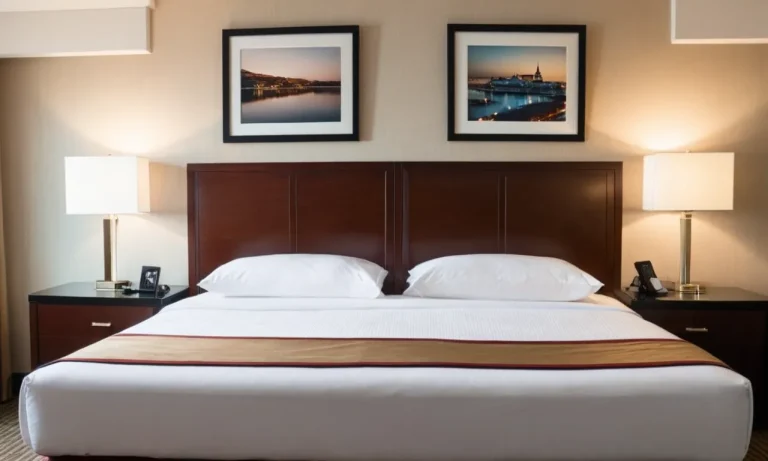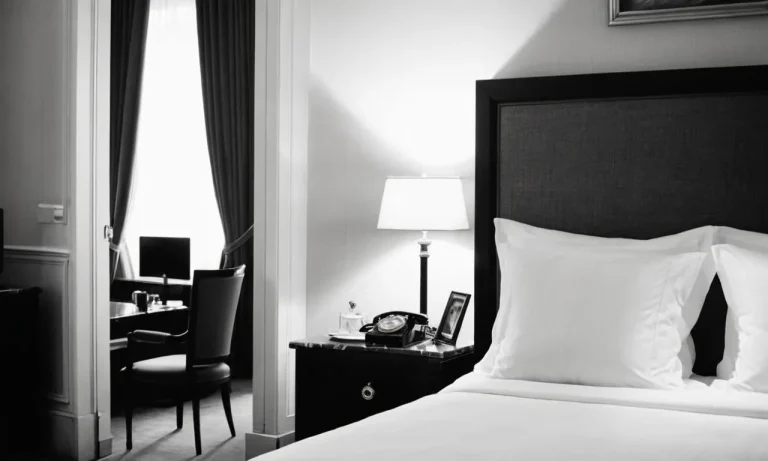How Do Hotels Make Money? A Comprehensive Guide
In the ever-evolving hospitality industry, hotels have become more than just a place to rest your head. They are intricate businesses that rely on various revenue streams to thrive and maintain profitability.
If you’re short on time, here’s a quick answer to your question: Hotels make money primarily through room rentals, but they also generate revenue from ancillary services such as food and beverage operations, spa and wellness facilities, event spaces, and other amenities.
In this comprehensive article, we’ll delve into the intricate details of how hotels generate income, exploring the various revenue sources and strategies employed by these establishments. From room rates and occupancy levels to ancillary services and innovative revenue streams, we’ll uncover the secrets behind a hotel’s financial success.
Room Revenue: The Backbone of Hotel Profitability
The lifeblood of any hotel’s financial success lies in its ability to maximize revenue from room bookings. After all, providing accommodation is the core service that hotels offer. The two key factors that drive room revenue are
Room Rates and Occupancy Levels
.
Room rates are the prices that hotels charge guests for their rooms. These rates can vary significantly based on factors like room type, seasonality, location, and amenities. Hotels aim to strike a balance between competitive pricing and maximizing revenue per available room (RevPAR), a key metric that combines room rates and occupancy levels.
According to data from Statista, the global average RevPAR for hotels in 2021 was around $55, a significant improvement from the pandemic-affected 2020 but still below pre-COVID levels.
Occupancy levels, on the other hand, refer to the percentage of available rooms that are occupied at any given time. Hotels strive for high occupancy rates, as vacant rooms represent lost revenue opportunities.
Achieving a healthy balance between room rates and occupancy is crucial for maximizing profitability. This is where
Revenue Management Strategies
come into play.
Revenue management involves using data analytics and pricing strategies to optimize room rates and availability. Hotels employ sophisticated algorithms and forecasting models to predict demand patterns and adjust rates accordingly.
Revionics, a leading provider of revenue management solutions, reports that their clients have seen RevPAR increases of up to 10% by leveraging their software. 😎
One key aspect of revenue management is addressing
Seasonal Fluctuations and Dynamic Pricing
. Hotel demand tends to fluctuate based on seasons, holidays, and events. During peak periods, hotels can command higher room rates, while during low seasons, they may need to offer discounts or promotions to attract guests.
Dynamic pricing strategies allow hotels to adjust their rates in real-time based on supply and demand, enabling them to capitalize on high-demand periods while filling rooms during slower times.
For example, a hotel in a popular beach destination might charge premium rates during the summer months when demand is high, while offering discounted rates in the off-season to attract leisure travelers and maintain a healthy occupancy level.
Similarly, hotels in business districts may see higher demand during weekdays and lower demand on weekends, prompting them to adjust rates accordingly. By effectively managing seasonal fluctuations and dynamic pricing, hotels can optimize their room revenue and profitability throughout the year. 👏
Food and Beverage Operations: A Lucrative Sideline
While the primary business of hotels revolves around providing accommodation, savvy hoteliers have long recognized the potential of food and beverage operations as a significant revenue stream. This sideline not only enhances the overall guest experience but also serves as a lucrative profit center for the establishment.
🤑💰
Restaurants and Bars
The heart of a hotel’s culinary offerings lies in its restaurants and bars. From casual dining spots to upscale eateries, these establishments cater to a diverse range of tastes and preferences. According to a Statista report, global hotel food and beverage sales amounted to a staggering $104.8 billion in 2021.
😮 By offering a variety of dining options, hotels can attract not only their guests but also locals and tourists alike, generating a steady stream of revenue.
Banquets and Catering Services
Weddings, conferences, and corporate events are just a few examples of the lucrative opportunities that hotels can capitalize on through their banquets and catering services. With their extensive facilities and professional staff, hotels are well-equipped to host grand celebrations and meetings.
According to Grand View Research, the global hotel banqueting market size was valued at $8.9 billion in 2021 and is expected to grow at a compound annual growth rate (CAGR) of 6.4% from 2022 to 2030. 📈 This presents a significant opportunity for hotels to diversify their revenue streams and cater to a wide range of events.
Room Service and Minibar Sales
While often overlooked, room service and minibar sales contribute significantly to a hotel’s bottom line. The convenience of having meals and snacks delivered directly to the guest’s room or readily available in the minibar is a luxury that many travelers are willing to pay a premium for.
According to a study by HospitalityNet, room service and minibar sales can account for up to 10% of a hotel’s total food and beverage revenue. 🍽️💰 By offering high-quality options and ensuring efficient service, hotels can tap into this lucrative market and enhance guest satisfaction.
Ancillary Services: Enhancing the Guest Experience
In today’s highly competitive hospitality industry, hotels are increasingly recognizing the importance of offering ancillary services to enhance the overall guest experience. These additional services not only serve as a source of revenue but also contribute to creating a memorable and enjoyable stay for visitors.
From luxurious spa facilities to state-of-the-art event spaces, ancillary services have become an integral part of the hotel business model.
Spa and Wellness Facilities
Spa and wellness facilities have become a coveted amenity for many hotel guests seeking relaxation and rejuvenation. According to a study by the Global Wellness Institute, the global wellness economy was valued at a staggering $4.4 trillion in 2020, with spa facilities playing a significant role.
Hotels have capitalized on this trend by offering a range of spa services, including massages, facials, body treatments, and wellness programs. Some hotels even feature state-of-the-art fitness centers, yoga studios, and meditation spaces to cater to health-conscious guests.
😊 By offering these services, hotels not only generate additional revenue but also differentiate themselves from competitors and attract guests seeking a holistic and rejuvenating experience.
Event Spaces and Meetings
Many hotels have recognized the lucrative potential of hosting events and meetings. From corporate conferences and seminars to weddings and social gatherings, these events can generate substantial revenue through room rentals, catering services, and additional amenities.
Hotels often feature versatile event spaces, such as ballrooms, conference rooms, and outdoor venues, equipped with the latest audio-visual technology and flexible seating arrangements. According to a report by Cvent, the global events industry was worth an estimated $1.07 trillion in 2018, and hotels have been capitalizing on this market by offering comprehensive event management services and customizable packages.
👏 By providing a seamless and memorable experience for event organizers and attendees, hotels can establish themselves as premier destinations for meetings and events.
Parking and Transportation Services
In urban areas where parking can be a challenge, hotels have seized the opportunity to offer parking and transportation services as an ancillary revenue stream. Many hotels operate their own parking facilities, charging guests and visitors for convenient and secure parking options.
Some hotels even offer valet parking services, adding an extra touch of luxury to the guest experience. Additionally, hotels may partner with local transportation companies or maintain their own fleet of vehicles to provide airport transfers, city tours, and limousine services.
These services not only generate revenue but also enhance guest convenience and accessibility, making the hotel a more attractive option for travelers.
While the core business of hotels revolves around providing accommodation, ancillary services have become a crucial component in enhancing the guest experience and driving revenue growth. By offering a diverse range of services, such as spa facilities, event spaces, and parking/transportation options, hotels can differentiate themselves, cater to diverse guest preferences, and capture a larger share of the hospitality market.
As the demand for unique and personalized experiences continues to rise, hotels that embrace and innovate in the realm of ancillary services are well-positioned to thrive in the ever-evolving hospitality landscape. 🎉
Innovative Revenue Streams: Staying Ahead of the Curve
In today’s competitive hospitality landscape, hotels are constantly seeking innovative ways to diversify their revenue streams and stay ahead of the curve. By embracing new trends and adapting to changing consumer preferences, savvy hoteliers can unlock additional sources of income beyond traditional room bookings.
Let’s explore three innovative revenue streams that are gaining traction in the industry.
Co-working Spaces and Business Centers
With the rise of remote work and the gig economy, hotels have recognized the potential of offering co-working spaces and business centers. These dedicated areas cater to entrepreneurs, freelancers, and remote workers seeking a professional environment outside of their homes or traditional offices.
By converting underutilized spaces into co-working hubs, hotels can generate additional revenue through membership fees, day passes, or hourly rates. According to a study by AllWork.Space, hotels with co-working spaces can generate up to 30% more revenue per available room compared to traditional hotels.
Retail Outlets and Gift Shops
Many hotels have embraced the concept of on-site retail outlets and gift shops, offering guests a convenient shopping experience without leaving the premises. These retail spaces can sell a wide range of products, from locally sourced souvenirs and artisanal goods to apparel, accessories, and travel essentials.
By curating a unique selection of merchandise, hotels can tap into the lucrative retail market and generate additional revenue. According to Hotel News Resource, on-site retail sales can contribute up to 10% of a hotel’s total revenue.
Partnerships and Sponsorships
Forging strategic partnerships and sponsorships with other businesses can be a win-win situation for hotels. By collaborating with brands, local attractions, or event organizers, hotels can offer exclusive packages, discounts, or experiences to their guests.
In return, they can earn a commission or a share of the revenue generated from these partnerships. For example, a hotel could partner with a local winery to offer wine tastings or with a nearby golf course to provide discounted tee times for guests.
According to HospitalityNet, successful partnerships can contribute up to 15% of a hotel’s total revenue.
By embracing these innovative revenue streams, hotels can diversify their income sources, enhance the guest experience, and stay competitive in an ever-evolving market. However, it’s crucial to carefully analyze the potential return on investment and align these initiatives with the hotel’s brand and target audience.
With a strategic approach and a willingness to adapt, hotels can unlock new opportunities for growth and profitability.
Cost Management and Operational Efficiency
Successful hotels understand the importance of cost management and operational efficiency in maximizing profitability. By carefully controlling expenses and streamlining operations, hotels can enhance their bottom line and stay competitive in the ever-evolving hospitality industry.
Here are some key areas where hotels can focus their efforts:
Labor Costs and Staffing Strategies
Labor costs are typically one of the largest expenses for hotels. Effective staffing strategies are crucial for maintaining a balance between providing exceptional service and controlling labor costs. Hotels can implement measures such as cross-training employees, utilizing part-time or seasonal workers, and leveraging technology to automate certain tasks.
According to a study by the American Hotel & Lodging Association (AHLA), labor costs account for approximately 45% of a hotel’s operating expenses.
Additionally, hotels can explore innovative scheduling practices, such as utilizing flexible work arrangements or implementing performance-based incentives, to boost employee productivity and engagement.
By optimizing their staffing levels and empowering their workforce, hotels can deliver high-quality service while managing labor costs effectively.
Energy and Utility Expenses
Energy and utility costs can significantly impact a hotel’s profitability. Hotels can implement energy-efficient practices, such as installing LED lighting, upgrading HVAC systems, and implementing smart building automation systems to monitor and control energy consumption.
According to the Environmental Protection Agency (EPA), energy-efficient hotels can save up to 30% on their energy bills.
Additionally, hotels can explore renewable energy sources like solar panels or participate in energy conservation programs offered by local utilities. By adopting sustainable practices, hotels not only reduce their operating costs but also contribute to environmental conservation efforts, which can enhance their brand reputation and appeal to eco-conscious travelers.
😊
Marketing and Promotional Efforts
Effective marketing and promotional strategies are essential for attracting guests and driving revenue. However, hotels must carefully manage their marketing budgets to ensure a positive return on investment (ROI).
According to a report by Hospitality Technology, hotels typically allocate between 2-5% of their revenue to marketing efforts.
Hotels can leverage digital marketing channels, such as social media, email campaigns, and search engine optimization (SEO), to reach their target audience cost-effectively. Additionally, they can explore partnerships with online travel agencies (OTAs) or implement loyalty programs to foster customer retention and repeat business.
By strategically allocating their marketing resources and leveraging data-driven insights, hotels can maximize their promotional efforts while controlling costs.
Conclusion
Hotels are complex businesses that rely on a multitude of revenue streams to maintain profitability and stay competitive in the ever-changing hospitality landscape. From room rentals and food and beverage operations to ancillary services and innovative revenue streams, these establishments employ a variety of strategies to maximize their income potential.
As the industry continues to evolve, hotels must remain agile and adaptable, constantly seeking new ways to enhance the guest experience while optimizing their revenue streams. By understanding the intricacies of how hotels make money, industry professionals and aspiring entrepreneurs can better navigate the challenges and opportunities that lie ahead, ensuring the long-term success of their establishments.







